
A team of middle school students in Baton Rouge research global warming and produce their take on the subject in this witty 30-second animated short
- Subject:
- Arts and Humanities
- Social Science
- Material Type:
- Lecture
- Date Added:
- 08/31/2012

A team of middle school students in Baton Rouge research global warming and produce their take on the subject in this witty 30-second animated short
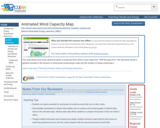
This map shows how much electrical power is produced from wind in each state from 1999 through 2010. The animation shows a general increase in the amount of wind power produced per state and the number of states producing it.
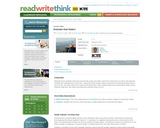
Following the traditional form of the haiku, students publish their own haikus using Animoto, an online web tool that creates slideshows that blend text and music.

In this Animating Civic Action lesson, from the Washington Office of Superintendent of Public Instruction and Washington State Governor's Office of the Education Ombuds, students listen to the story of Jared, a student experiencing homelessness. Students are asked to examine what it means to be homeless, to identify how homelessness affects people and to and to consider ways they can act to take action against homelessness in their school community.
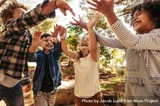
In this Animating Civic Action lesson, from the Washington Office of Superintendent of Public Instruction, students listen to the story of Esther, a student refugee, about her experience in school. Students are asked to examine what it means to stereotype others, and to consider ways they can act to make their community more welcoming and inclusive.
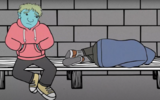
In this Animating Civic Action lesson, from the Washington Office of Superintendent of Public Instruction and Washington State Governor's Office of the Education Ombuds, students listen to the story of Jared, a student experiencing homelessness. Students are asked to examine what it means to be homeless, to identify how homelessness affects people and to and to consider ways they can act to take action against homeless n their school community.

Often throughout American history former refugees rise to be community leaders dedicating their lives to helping others. Refugees often overcome key obstacles including language and culture to become important activists addressing social and political problems. Refugees offer key perspectives on the application of civic virtues and human rights. In this lesson students will hear from three refugee students about their experiences. Then, students will be asked to:Identify and describe obstacles student refugees encounter while assimilating at school.Identify reasons why refugees go on to develop a strong sense of civic duty and desire to give back to their communities. Research and identify ways they can take civic action to build a better community.
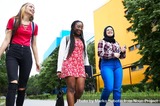
Students will build empathy to be “helpers” and make a difference in the lives of others through consideration of two questions: How can we listen effectively to better understand people’s stories, and how can we respond to and communicate effectively to peoples’ stories? Students will then propose opportunities to take action to improve our community response to support all students and their communities.
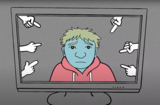
In this Animating Civic Action lesson, from the Washington Office of Superintendent of Public Instruction and Washington State Governor's Office of the Education Ombuds, students listen to the story of Jared, a student experiencing homelessness. Students are asked to examine what it means to be homeless, to identify how homelessness affects people and to and to consider ways they can act to take action against homelessness in their school community.

An overview of Animating DOM with setInterval
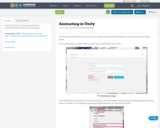
A short tutorial on creating an animated two-dimensional sprite in the Unity game engine.

Learn how to use jQuery to animate elements in custom ways, like animating their sizes, borders, and spacing, to whatever values you specify.
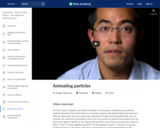
Now we'll pull everything together and explore how we calculate the position of a particle over time (frame by frame).

An overview of Animating styles with CSS animations

An overview of Animating styles with requestAnimationFrame

Learn how to use jQuery to show, hide, and toggle elements with animation effects.
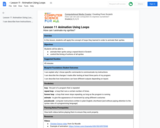
In this lesson, students will apply the concept of loops they learned in order to animate their sprites.
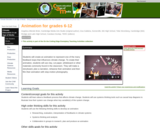
Students will create an animation to represent one of the many feedback loops that influences climate change. To create their animation, students will use clay, cut paper, whiteboard or other materials commonly found in the classroom. They will make a storyboard, plan a narration, rehearse their animation and then film their animation with stop-motion photography.
(Note: this resource was added to OER Commons as part of a batch upload of over 2,200 records. If you notice an issue with the quality of the metadata, please let us know by using the 'report' button and we will flag it for consideration.)
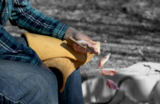
Explore the physics and material science of making stone tools. Educator Nate Salzman walks us through the surprisingly complex science of flintknapping, or the process of turning stone into blades, arrowheads, spear points, axes, jewelry and more. Making tools from stone may be thousands of years old, but required people to think about the properties of the material they were using and the physics of striking the stone to shape it just right.NOTE: These are animations derived from the video "The Science of Knapping" which is linked here and published under its own listing on OER Commons.This resource is part of Jefferson Patterson Park and Museum’s open educational resources project to provide history, ecology, archaeology, and conservation resources related to our 560 acre public park. More of our content can be found on YouTube and SketchFab. JPPM is a part of the Maryland Historical Trust under the Maryland Department of Planning.

I wanted to make a realistic animatronic heart, and as I was developing the 3D printed mechanism I used a sock to try and get a vague idea of how the silicone skin would move once the design was finished. Since the silicone casting turned out to be quite challenging and very expensive, the sock test gave me the idea to instead use a slightly elastic fabric to make a plush heart design, which could be fitted over the 3D printed mechanism.
This project is very simple on the 3D printing/assembly/electronics side, but I'd recommend you have a little sewing experience because, as a sewing amateur, I'm not 100% confident in my patterns. A sewing machine is not necessarily required and a lot of the sewing is by hand anyway, but it would certainly be useful!